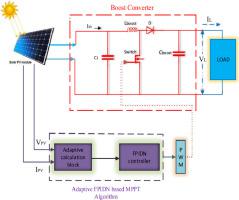当前位置:
X-MOL 学术
›
Comput. Electr. Eng.
›
论文详情
Our official English website, www.x-mol.net, welcomes your
feedback! (Note: you will need to create a separate account there.)
Simulation and experimental design of adaptive-based maximum power point tracking methods for photovoltaic systems
Computers & Electrical Engineering ( IF 4.0 ) Pub Date : 2021-01-01 , DOI: 10.1016/j.compeleceng.2020.106910 P. Srinivasarao , K. Peddakapu , M.R. Mohamed , K.K. Deepika , K. Sudhakar
Computers & Electrical Engineering ( IF 4.0 ) Pub Date : 2021-01-01 , DOI: 10.1016/j.compeleceng.2020.106910 P. Srinivasarao , K. Peddakapu , M.R. Mohamed , K.K. Deepika , K. Sudhakar

|
Abstract This paper presents a filter-based adaptive fuzzy proportional integral derivative (FPIDN) controller for photovoltaic (PV) systems. The proposed maximum power point tracking (MPPT) method is implemented in two blocks. The first block represents by an adaptive calculation block; to produce a reference voltage for every maximum power point (MPP), whereas the second is the FPIDN controller; utilized to manage duty cycle of the PWM converter. The effectiveness of the proposed MPPT has been evaluated to different MPPT methods. The efficiency of the proposed MPPT recorded at 99.45% and 99.72% with MPP capture time clocks at 0.048s, outperforms the benchmarked traditional MPPT methods under diverse irradiance and temperature conditions.
中文翻译:

基于自适应的光伏系统最大功率点跟踪方法仿真与实验设计
摘要 本文提出了一种用于光伏 (PV) 系统的基于滤波器的自适应模糊比例积分微分 (FPIDN) 控制器。建议的最大功率点跟踪 (MPPT) 方法在两个模块中实现。第一个块代表一个自适应计算块;为每个最大功率点 (MPP) 产生一个参考电压,而第二个是 FPIDN 控制器;用于管理 PWM 转换器的占空比。所提出的 MPPT 的有效性已针对不同的 MPPT 方法进行了评估。所提出的 MPPT 的效率记录为 99.45% 和 99.72%,MPP 捕获时钟为 0.048 秒,在不同的辐照度和温度条件下优于基准的传统 MPPT 方法。
更新日期:2021-01-01
中文翻译:

基于自适应的光伏系统最大功率点跟踪方法仿真与实验设计
摘要 本文提出了一种用于光伏 (PV) 系统的基于滤波器的自适应模糊比例积分微分 (FPIDN) 控制器。建议的最大功率点跟踪 (MPPT) 方法在两个模块中实现。第一个块代表一个自适应计算块;为每个最大功率点 (MPP) 产生一个参考电压,而第二个是 FPIDN 控制器;用于管理 PWM 转换器的占空比。所提出的 MPPT 的有效性已针对不同的 MPPT 方法进行了评估。所提出的 MPPT 的效率记录为 99.45% 和 99.72%,MPP 捕获时钟为 0.048 秒,在不同的辐照度和温度条件下优于基准的传统 MPPT 方法。











































 京公网安备 11010802027423号
京公网安备 11010802027423号